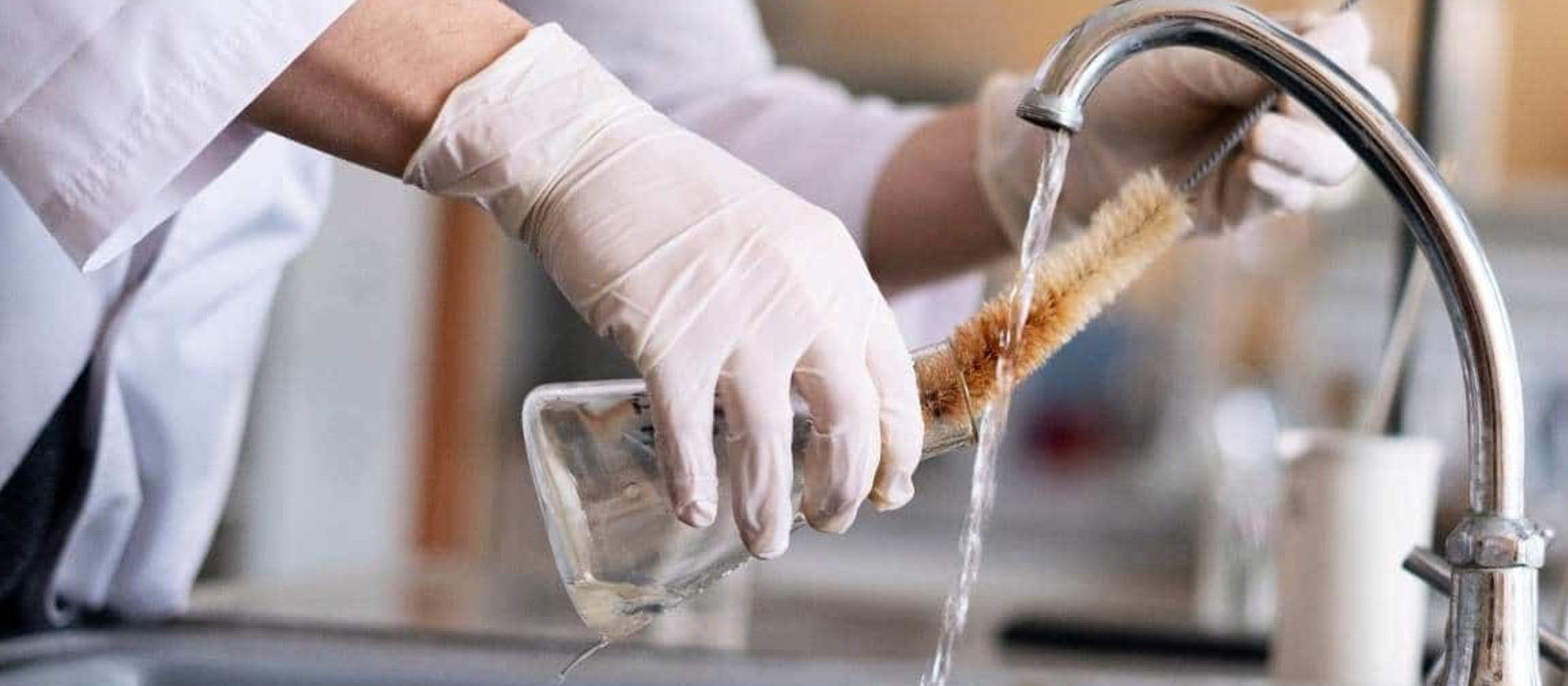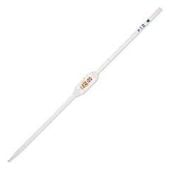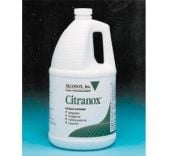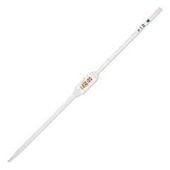Methods for Cleaning Laboratory Glassware
Good Laboratory Technique demands clean Glassware, because the most carefully executed piece of work may give an erroneous result if dirty glassware is used.
In all instances, glassware must be physically clean; it must be chemically clean; and in many cases, it must be sterile. All glassware must be absolutely grease-free. The safest criterion of cleanliness is uniform wetting of the surface by distilled water. This is especially important in glassware used for measuring the volume of liquids.

Grease and other contaminating materials will prevent the glass from becoming uniformly wetted. When grease is involved, a preliminary, short rinse with an organic solvent may be necessary. This in turn will alter the volume of residue adhering to the walls of the glass container and thus affect the volume of liquid measured or delivered.
Furthermore, in pipets and burets, the meniscus will be distorted and the correct adjustments cannot be made. The presence of small amounts of impurities may also alter the meniscus.
Safety Considerations
Eye protection and heavy-duty slip-resistant, chemically-resistant gloves should be used when washing glassware. Depending on the detergents and cleaning solutions being used, an apron and fume hood may also be required.
Manufacturers of laboratory glassware, such as Corning, the manufacturer of Pyrex, may recommend a wide variety of cleaning solutions, including biodegradable phosphate-free and chromium-free formulations. Instructions for using these solutions should be read and closely followed. These will be available for purchase through many laboratory supply companies.
Instructions for using these solutions should be read and closely followed. Always wash the exposed area with repeated water rinses to avoid burns when using any cleaning solution that comes in contact with the skin. Always read the Material Safety Data Sheets of the cleaning solutions being employed.
Afterward, a thorough water rinse should follow until all traces of unwanted materials are removed – including the solvent. If the glassware is to be calibrated, distilled water should be utilized for the final rinse. Graduated Laboratory Glassware that is marked “to contain” should be dried using acetone or ethyl alcohol, and clean air blown into the vessel – in a fume hood – will hasten the drying process.
Abrasive materials should be avoided when wiping down or cleaning laboratory glassware is necessary as they will damage the surface. Autoclaving may be necessary for some applications. When cleaning with an autoclave, it is recommended that instructions supplied with the instrument be followed closely.
Cleaning Glassware
It is generally agreed that laboratory glassware should be soaked immediately after use to eliminate the danger of caking of residues. The longer it is left unwashed, the harder it will be to clean. If a thorough cleaning is not immediately possible, disassemble the glassware and put it to soak in water. This is especially important for ground glass stopcocks and stoppers.
If glassware is not cleaned immediately, it may become impossible to remove the residue. Do not overload sinks, dishwashers, or soaking bins. Rubber sink and counter mats can help reduce the chance of breakage and resultant injury.
Most new glassware is slightly alkaline in reaction. For precision chemical tests, new glassware should be soaked for several hours in acid water (a 1% solution of hydrochloric or nitric acid) before washing.
Cleaning Pipets
1. Place pipets, tips down, in a cylinder or tall jar of water immediately after use. Do not drop them into the jar since this may break or chip the tips and render the pipets useless for accurate measurements. A pad of cotton or glass wool at the bottom of the jar will help prevent the tips from breaking. Be certain that the water level is high enough to immerse the greater portion or all of each pipet.
2. At a convenient time, the pipets may then be drained and placed in a cylinder or jar of dissolved detergent or, if exceptionally dirty, in a jar of chromic acid cleaning solution. After soaking for several hours or overnight, drain the pipets and run tap water over and through them until all traces of dirt are removed. Soak the pipets in distilled water for at least 1 hour. Remove from the distilled water, rinse, dry the outside with a cloth, shake the water out, and dry.
In laboratories where a large number of pipets are used daily, it is convenient to use an automatic pipet washer. Some of these pieces of equipment are made of metal and are quite elaborate. These can be connected directly by permanent fixtures to the hot and cold water supplies.
Others, such as those made with polyethylene, are less elaborate and can be attached to the water supplies by a rubber hose. Polyethylene baskets and jars may be used for soaking and rinsing pipets in a chromic acid cleaning solution. Electrically heated metallic pipet driers are also available.
After drying, place chemical pipets in a dust-free drawer. Wrap serologic and bacteriologic pipets in paper, place them in pipet cans, and sterilize them in a dry air sterilizer at 180°C for 2 hours.
Pipets used for transferring infectious material should have a plug of cotton placed in the top end of the pipet before sterilizing. This plug of cotton will prevent the material from being drawn accidentally into the pipetting device. The Lab Depot also offers a full line of sterile, ready-to-use, disposable glass and plastic pipets to eliminate the need for cleaning and sterilizing.
Cleaning Burets
1. Remove the stopcock or rubber tip and wash the buret with detergent and water. Wash the stopcock or rubber tip separately.
2. Rinse with tap water until all the dirt is removed.
3. Then rinse with distilled water and dry.
4. Before placing a glass stopcock in the buret, lubricate the joint with stopcock lubricant. Use only a small amount of lubricant.
Please Note: Burets should always be covered when not in use.
Cleaning Culture Tubes
1. Culture tubes that have been used previously must be sterilized before cleaning. The best general method for sterilization cultures is by autoclaving for 30 minutes at 121°C (15 lb. pressure).
2. Media that solidifies on cooling should be poured out while the tubes are hot. After the tubes are emptied, brush with detergent and water, rinse thoroughly with tap water, rinse with distilled water, place in a basket, and dry.
3. After the tubes are emptied, brush with detergent and water, rinse thoroughly with tap water, rinse with distilled water, place in a basket, and dry.
If tubes are to be filled with a medium that is sterilized by autoclaving, do not plug until the medium is added. Both medium and tubes are sterilized with one autoclaving.
If the tubes are to be filled with a sterile medium, plug and sterilize the tubes in the autoclave or dry air sterilizer before adding the medium. Corning also offers a variety of disposable glass and plastic culture tubes to eliminate the need for cleaning.
Cleaning Slides and Cover Glass
It is especially important that microscope slides and cover glass used for the preparation of blood films or bacteriologic smears be perfectly clean and free from scratches.
1. Wash slides with appropriate solutions.
2. Place clean slides in glacial acetic acid for 10 minutes.
3. After acid treatment, rinse with distilled water.
4. Wipe dry with clean paper towels or cloth.
5. After acid treatment and rinsing, slides may be placed in a wide jar and covered with alcohol.
7. Before use, as needed, remove from the jar, wash with alcohol, and wipe dry.
Rinsing, Drying and Storing Glassware
When rinsing or washing pipets, cylinders or burets be careful not to let tips hit the sink or the water tap. Most breakage occurs in this way. Dry test tubes, culture tubes, flasks, and other glassware by hanging them on wooden pegs or placing them in baskets with their mouths downward and allowing them to air dry.
Alternatively, place them in baskets and dry them in an oven. The temperature for drying should not exceed 140°C. Never apply heat directly to empty glassware used for volumetric measurements. Such glassware should be dried at temperatures of no more than 80°C to 90°C.
Before placing glassware in a basket, cover the bottom of the basket with a clean folded towel or a clean piece of cloth. This prevents the mouths of the tubes from becoming dirty.
Dry burets, pipets, and cylinders by standing them on a folded towel. Protect clean glassware from dust by plugging with cotton, corking, taping a heavy piece of paper over the mouth, or placing the glassware in a dust-free cabinet.
When storing, place pieces in racks designed especially for them. Be sure pieces do not touch each other, to avoid inadvertent mechanical damage.
Do not store glassware close to the front edge of shelves. Do not store alkaline liquids in volumetric flasks or burets. Stoppers or stopcocks may stick.





















